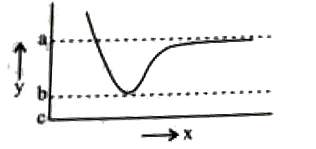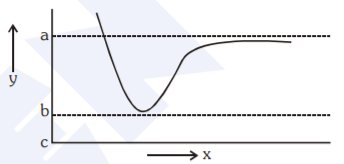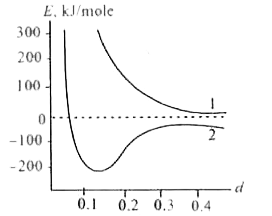The potential energy (y) curve for H2 formation as a function of internuclear distance (x) of the H atoms is shown below.

The bond energy of H2 is
(c−a)2
(b−a)2
(c−a)
(b−a)
The correct Answer is:D
Potential energy of two H atoms at infinite distance = a Potential energy of two H atoms at distance equal to bond length = b
So, The bond energy of H2 = (b-a)
Topper's Solved these Questions
- CHEMICAL BONDING AND MOLECULAR STRUCTURE BOOK - PHYSICS WALLAHCHAPTER - CHEMICAL BONDING AND MOLECULAR STRUCTURE EXERCISE - Level -2
48 Videos
- BIOMOLECULESBOOK - PHYSICS WALLAHCHAPTER - BIOMOLECULESEXERCISE - NEET PAST 5 YEARS QUESTIONS
13 Videos
- CHEMISTRY IN EVERDAY LIFE BOOK - PHYSICS WALLAHCHAPTER - CHEMISTRY IN EVERDAY LIFE EXERCISE - NEET PAST 5 YEARS QUESTIONS
6 Videos
Similar Questions
Knowledge Check
The potential energy(y) curve for H2 formation as a function of inrtnuclear distance(x) of the H atoms is shown below

The bond energy of H2 is :Ab−aBc−a2Cb−a2Dc-aIn the potential energy curve for the formation of H2 molecule as a function of internuclear distance of H atoms, what happens at the minimum in the curve?
Anet force of attraction equals to of force repulsionBmost stable state of H2 is achievedCsystem aquires minimum energyDAll of theseH2(g)=2H(g),ΔH=104.2kcal. The bond energy of H-Hbond is
A104.2 kcalB208.4 kcalC52.1 kcalDZero
The potential energy curve for the H2 molecule as a function of internuclear distance is :
View SolutionThe figure is the plot potential energy versus internuclear distance (d) of H2 molecule in the electronic ground state. What is the value of the net potential energy E0 (as indicated in the figure) in kJ mol−1 , for d=d0 at which the electron repulsion and the nucleus - nucleus repulsion energies are absent ? As reference , the potential energy of H atom is taken as zero when its electron and the nucleus are infinitely far apart.
use Avogadro as 6.023×1023mol−1.

View SolutionThe bond energy of H2 is 436-4 kJ. This means that
View SolutionConsider the given figure showing that possible levels of the energy of H+2 ion depending on internuclear distance versus potential energy of the system.

It may be easily assumed that the ground state of the molecular hydrogen ion H+2 corresponds to the lowest level which means that
View SolutionEnergy required to dissociate 4 g of gaseous H2 into free gaseous atoms is 872 kJ at 25∘C. The bond energy of H-H bond will be
View Solution
